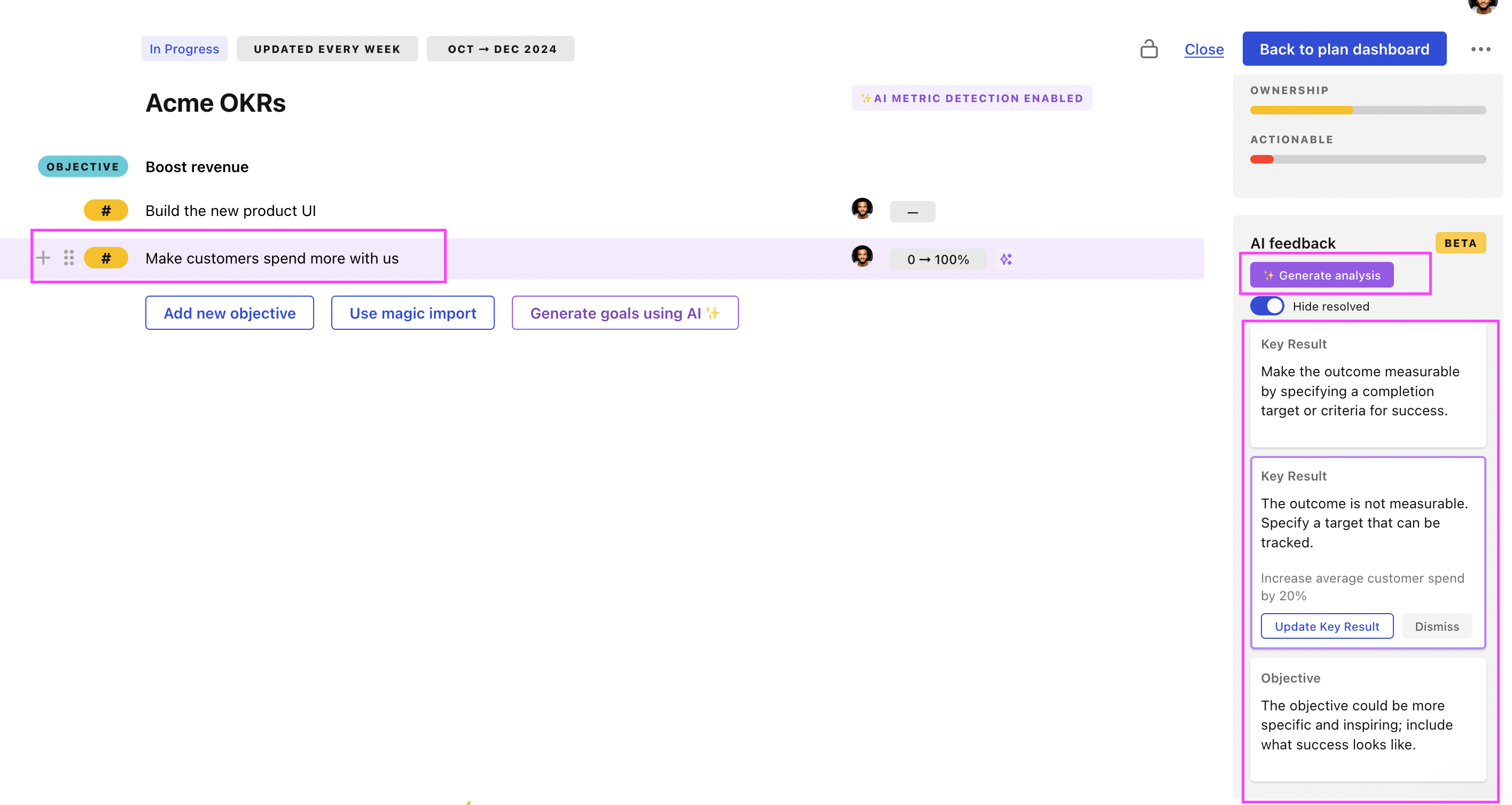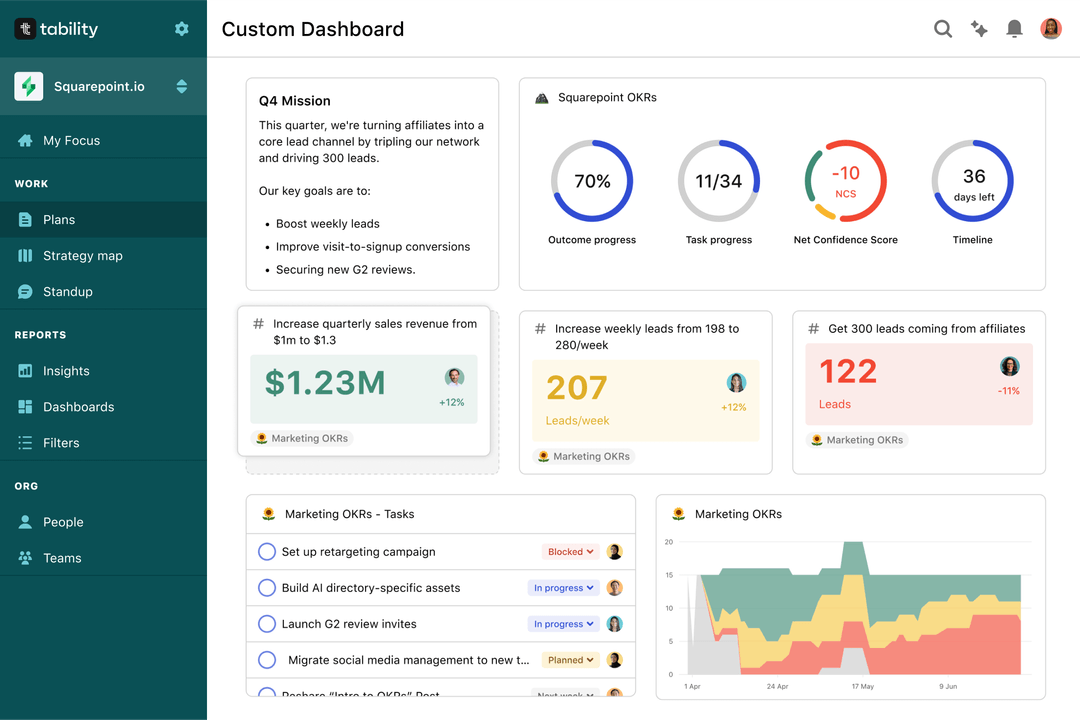Tability is a cheatcode for goal-driven teams. Set perfect OKRs with AI, stay focused on the work that matters.
What are Maintenance Request Processing OKRs?
The Objective and Key Results (OKR) framework is a simple goal-setting methodology that was introduced at Intel by Andy Grove in the 70s. It became popular after John Doerr introduced it to Google in the 90s, and it's now used by teams of all sizes to set and track ambitious goals at scale.
How you write your OKRs can make a huge difference on the impact that your team will have at the end of the quarter. But, it's not always easy to write a quarterly plan that focuses on outcomes instead of projects.
That's why we have created a list of OKRs examples for Maintenance Request Processing to help. You can use any of the templates below as a starting point to write your own goals.
If you want to learn more about the framework, you can read our OKR guide online.
The best tools for writing perfect Maintenance Request Processing OKRs
Here are 2 tools that can help you draft your OKRs in no time.
Tability AI: to generate OKRs based on a prompt
Tability AI allows you to describe your goals in a prompt, and generate a fully editable OKR template in seconds.
- 1. Create a Tability account
- 2. Click on the Generate goals using AI
- 3. Describe your goals in a prompt
- 4. Get your fully editable OKR template
- 5. Publish to start tracking progress and get automated OKR dashboards
Watch the video below to see it in action 👇
Tability Feedback: to improve existing OKRs
You can use Tability's AI feedback to improve your OKRs if you already have existing goals.
- 1. Create your Tability account
- 2. Add your existing OKRs (you can import them from a spreadsheet)
- 3. Click on Generate analysis
- 4. Review the suggestions and decide to accept or dismiss them
- 5. Publish to start tracking progress and get automated OKR dashboards

Tability will scan your OKRs and offer different suggestions to improve them. This can range from a small rewrite of a statement to make it clearer to a complete rewrite of the entire OKR.
Maintenance Request Processing OKRs examples
We've added many examples of Maintenance Request Processing Objectives and Key Results, but we did not stop there. Understanding the difference between OKRs and projects is important, so we also added examples of strategic initiatives that relate to the OKRs.
Hope you'll find this helpful!
OKRs to implement a digitized maintenance request system
ObjectiveImplement a digitized maintenance request system
KRFully design the digital request interface by mid-quarter
Define interface requirements and functionalities
Test and finalize interface design
Create wireframes and digital request prototypes
KRReduce physical request submissions by 70%
Conduct training for digital request submission
Implement an online submission portal for requests
Promote e-submission benefits to clients
KRAchieve 85% employee proficiency in utilizing the system
Offer frequent, comprehensive training on system usage
Implement proficiency metrics and regular testing
Provide immediate technical support for any issues
OKRs to improve efficacy of maintenance request processing
ObjectiveImprove efficacy of maintenance request processing
KRAchieve a 95% positive satisfaction rating on maintenance services
Provide professional development training to all maintenance staff
Regularly survey clients regarding maintenance satisfaction
Implement a rigorous quality control check for all maintenance services
KRImplement a new maintenance request tracking system with proper training for all staff
Select and purchase a maintenance request tracking system
Plan and develop a comprehensive staff training program
Schedule and conduct staff training sessions
KRReduce average response time for maintenance requests by 25%
Implement new, efficient maintenance request tracking system
Train staff in problem-solving and quick response
Prioritize urgent maintenance requests
Maintenance Request Processing OKR best practices
Generally speaking, your objectives should be ambitious yet achievable, and your key results should be measurable and time-bound (using the SMART framework can be helpful). It is also recommended to list strategic initiatives under your key results, as it'll help you avoid the common mistake of listing projects in your KRs.
Here are a couple of best practices extracted from our OKR implementation guide 👇
Tip #1: Limit the number of key results
The #1 role of OKRs is to help you and your team focus on what really matters. Business-as-usual activities will still be happening, but you do not need to track your entire roadmap in the OKRs.
We recommend having 3-4 objectives, and 3-4 key results per objective. A platform like Tability can run audits on your data to help you identify the plans that have too many goals.
Tip #2: Commit to weekly OKR check-ins
Don't fall into the set-and-forget trap. It is important to adopt a weekly check-in process to get the full value of your OKRs and make your strategy agile – otherwise this is nothing more than a reporting exercise.
Being able to see trends for your key results will also keep yourself honest.
Tip #3: No more than 2 yellow statuses in a row
Yes, this is another tip for goal-tracking instead of goal-setting (but you'll get plenty of OKR examples above). But, once you have your goals defined, it will be your ability to keep the right sense of urgency that will make the difference.
As a rule of thumb, it's best to avoid having more than 2 yellow/at risk statuses in a row.
Make a call on the 3rd update. You should be either back on track, or off track. This sounds harsh but it's the best way to signal risks early enough to fix things.
Save hours with automated Maintenance Request Processing OKR dashboards

OKRs without regular progress updates are just KPIs. You'll need to update progress on your OKRs every week to get the full benefits from the framework. Reviewing progress periodically has several advantages:
- It brings the goals back to the top of the mind
- It will highlight poorly set OKRs
- It will surface execution risks
- It improves transparency and accountability
Most teams should start with a spreadsheet if they're using OKRs for the first time. Then, you can move to Tability to save time with automated OKR dashboards, data connectors, and actionable insights.
How to get Tability dashboards:
- 1. Create a Tability account
- 2. Use the importers to add your OKRs (works with any spreadsheet or doc)
- 3. Publish your OKR plan
That's it! Tability will instantly get access to 10+ dashboards to monitor progress, visualise trends, and identify risks early.
More Maintenance Request Processing OKR templates
We have more templates to help you draft your team goals and OKRs.
OKRs to boost our digital subscription numbers
OKRs to enhance intelligent product recommendation engine for improved customer matching
OKRs to enhance operational efficiency through optimal resource utilization
OKRs to achieve complete regulatory compliance
OKRs to achieve a higher level of English fluency and confidence
OKRs to enhance the quality of customer support services